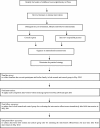A school-based comprehensive lifestyle intervention among chinese kids against obesity (CLICK-Obesity): rationale, design and methodology of a randomized controlled trial in Nanjing city, China
- PMID: 22545755
- PMCID: PMC3376033
- DOI: 10.1186/1471-2458-12-316
A school-based comprehensive lifestyle intervention among chinese kids against obesity (CLICK-Obesity): rationale, design and methodology of a randomized controlled trial in Nanjing city, China
Abstract
Background: The prevalence of childhood obesity among adolescents has been rapidly rising in Mainland China in recent decades, especially in urban and rich areas. There is an urgent need to develop effective interventions to prevent childhood obesity. Limited data regarding adolescent overweight prevention in China are available. Thus, we developed a school-based intervention with the aim of reducing excess body weight in children. This report described the study design.
Methods/design: We designed a cluster randomized controlled trial in 8 randomly selected urban primary schools between May 2010 and December 2013. Each school was randomly assigned to either the intervention or control group (four schools in each group). Participants were the 4th graders in each participating school. The multi-component program was implemented within the intervention group, while students in the control group followed their usual health and physical education curriculum with no additional intervention program. The intervention consisted of four components: a) classroom curriculum, (including physical education and healthy diet education), b) school environment support, c) family involvement, and d) fun programs/events. The primary study outcome was body composition, and secondary outcomes were behaviour and behavioural determinants.
Discussion: The intervention was designed with due consideration of Chinese cultural and familial tradition, social convention, and current primary education and exam system in Mainland China. We did our best to gain good support from educational authorities, school administrators, teachers and parents, and to integrate intervention components into schools' regular academic programs. The results of and lesson learned from this study will help guide future school-based childhood obesity prevention programs in Mainland China.
Registration number: ChiCTR-ERC-11001819.
Figures
References
-
- Zhao W, Zhai Y, Hu J, Wang J, Yang Z, Kong L, Chen C. Economic burden of obesity-related chronic diseases in Mainland China. Obes Rev. 2008;9(Suppl 1):62–67. - PubMed
Publication types
MeSH terms
Grants and funding
LinkOut - more resources
Full Text Sources
Medical



